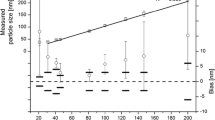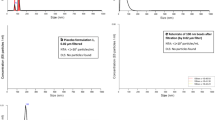Abstract
Purpose
Nanoparticle tracking analysis (NTA) is an emerging technique for the analysis of particles in the submicron range of 50–1000 nm. It tracks the Brownian motion of individual particles and calculates the diffusion coefficient and subsequently the hydrodynamic diameter based on the Stokes-Einstein equation. In this study, we provide guidance on the capabilities and limitations using NTA for particle analysis.
Method
We have used polystyrene (PS) particle size standards to evaluate various experimental parameters such as the influence of particle concentration, measurement temperature, and neutral density (ND) filter on sizing and counting. We have also used bimodal samples in different ratios to assess the resolution power of NTA as well as trimodal samples to evaluate two different analysis algorithms.
Results
Within the working range of 106–109 particles/mL, lower particle concentrations of monomodal samples lead to an increase in the detected particle size but allow for more accurate particle concentration measurements. The measurement temperature in the range of 21 °C to 29 °C causes a trend of increasing particle size up to 8 % with increasing temperature. The use of a neutral density filter increases the accuracy of particle size measurements for larger particles, e.g., 800 nm PS beads. The analysis of bimodal or trimodal samples is challenging due to variations in the readout depending on instrument settings and experimental parameters.
Conclusion
In this study, we have addressed several experimental parameters that affect the measurements, and we aim to provide guidance to the scientific community using NTA analysis.






Similar content being viewed by others
Data Availability
The datasets generated during and/or analyzed during the current study are available from the corresponding author on reasonable request.
References
Cromwell MEM, Hilario E, Jacobson F. Protein aggregation and bioprocessing. AAPS J. 2006;8:E572–9. https://doi.org/10.1208/aapsj080366.
Hermeling S, Crommelin DJA, Schellekens H, Jiskoot W. Structure-immunogenicity relationships of therapeutic proteins. Pharmaceut Res. 2004;21:897–903. https://doi.org/10.1023/b:pham.0000029275.41323.a6.
Ripple DC, Dimitrova MN. Protein particles: what we know and what we do not know. J Pharm Sci. 2012;101:3568–79. https://doi.org/10.1002/jps.23242.
Garidel P, Kuhn AB, Schäfer LV, Karow-Zwick AR, Blech M. High-concentration protein formulations: how high is high? Eur J Pharm Biopharm. 2017;119:353–60. https://doi.org/10.1016/j.ejpb.2017.06.029.
Corvari V, Narhi LO, Spitznagel TM, Afonina N, Cao S, Cash P, et al. Subvisible (2–100 μm) Particle analysis during biotherapeutic drug product development: part 2. Experience with the application of subvisible particle analysis. Biologicals. 2015;43:457–73. https://doi.org/10.1016/j.biologicals.2015.07.011.
Narhi LO, Corvari V, Ripple DC, Afonina N, Cecchini I, Defelippis MR, et al. Subvisible (2–100 μm) particle analysis during biotherapeutic drug product development: part 1. Considerations and strategy. J Pharm Sci. 2015;104:1899–908. https://doi.org/10.1002/jps.24437.
Gross-Rother J, Blech M, Preis E, Bakowsky U, Garidel P. Particle detection and characterization for biopharmaceutical applications: current principles of established and alternative techniques. Pharmaceutics. 2020;12:1112. https://doi.org/10.3390/pharmaceutics12111112.
Wang W, Nema S, Teagarden D. Protein aggregation—pathways and influencing factors. Int J Pharm. 2010;390:89–99. https://doi.org/10.1016/j.ijpharm.2010.02.025.
Garidel P, Kebbel F. Protein therapeutics and aggregates characterized by photon correlation spectroscopy. BioProcess International. 2010;8:38–46.
Blech M, Melien R, Tschammer N, Presser B, Hinderberger D, Garidel P. Expanding the toolbox for predictive parameters describing antibody stability considering thermodynamic and kinetic determinants. Pharm Res. 2021;38:2065–89. https://doi.org/10.1007/s11095-021-03120-x.
Narhi LO, Schmit J, Bechtold-Peters K, Sharma D. Classification of protein aggregates. J Pharm Sci. 2012;101:493–8. https://doi.org/10.1002/jps.22790.
Garidel P, Herre A, Kliche W. Microscopic methods for particle characterization in protein pharmaceuticals. In: Mahler HC, Jiskoot W, editors. Analysis of aggregates and particles in protein pharmaceuticals. 1st ed. Hoboken, New Jersey: John Wiley & Sons Inc; 2012. p. 269–302. https://doi.org/10.1002/9781118150573.ch12. Chapter 12.
Moussa EM, Panchal JP, Moorthy BS, Blum JS, Joubert MK, Narhi LO, et al. Immunogenicity of therapeutic protein aggregates. J Pharm Sci. 2016;105:417–30. https://doi.org/10.1016/j.xphs.2015.11.002.
Langille SE. Particulate matter in injectable drug products. PDA J Pharm Sci Tech. 2013;67:186–200. https://doi.org/10.5731/pdajpst.2013.00922.
Kijanka G, Bee JS, Korman SA, Wu Y, Roskos LK, Schenerman MA, et al. Submicron size particles of a murine monoclonal antibody are more immunogenic than soluble oligomers or micron size particles upon subcutaneous administration in mice. J Pharm Sci. 2018;107:2847–59. https://doi.org/10.1016/j.xphs.2018.06.029.
Swanson MD, Rios S, Mittal S, Soder G, Jawa V. Immunogenicity risk assessment of spontaneously occurring therapeutic monoclonal antibody aggregates. Front Immunol. 2022;13: 915412. https://doi.org/10.3389/fimmu.2022.915412.
Singh SK, Afonina N, Awwad M, Bechtold-Peters K, Blue JT, Chou D, et al. An industry perspective on the monitoring of subvisible particles as a quality attribute for protein therapeutics. J Pharm Sci. 2010;99:3302–21. https://doi.org/10.1002/jps.22097.
Fawaz I, Schaz S, Boehrer A, Garidel P, Blech M. Micro-flow imaging multi-instrument evaluation for sub-visible particle detection. Eur J Pharm Biopharm. 2023;185:55–70. https://doi.org/10.1016/j.ejpb.2023.01.017.
Schleinzer F, Strebl M, Blech M, Garidel P. Backgrounded membrane imaging—a valuable alternative for particle detection of biotherapeutics? J Pharm Innov. 2023; 18:1–19. https://doi.org/10.1007/s12247-023-09734-5.
Benkstein KD, Balakrishnan G, Bhirde A, Chalus P, Das TK, Do N, et al. An interlaboratory comparison on the characterization of a sub-micrometer polydisperse particle dispersion. J Pharm Sci. 2022;111:699–709. https://doi.org/10.1016/j.xphs.2021.11.006.
Telikepalli SN, Carrier MJ, Ripple DC, Barnett G, Bhirde A, Bolton D, et al. An interlaboratory study to identify potential visible protein-like particle standards. AAPS PharmSciTech. 2022;24:18. https://doi.org/10.1208/s12249-022-02457-9.
FDA US. Guidance for industry: immunogenicity assessment for therapeutic protein products. US FDA; 2014. https://www.fda.gov/media/85017/download. Accessed 5 Feb 2024.
Roesch A, Zölls S, Stadler D, Helbig C, Wuchner K, Kersten G, et al. Particles in biopharmaceutical formulations, part 2: an update on analytical techniques and applications for therapeutic proteins, viruses, vaccines and cells. J Pharm Sci. 2021;111:933–50. https://doi.org/10.1016/j.xphs.2021.12.011.
Europäisches Arzneibuch. 6th ed. Deutscher Apotheker Verlag. 2022, ISBN 978-3-7692-8110-1; 2022.
USP-NF 2021 Issue 1: The United States Pharmacopeia and National Formulary. 2021. https://online.uspnf.com/uspnf. Accessed 5 Feb 2024.
Gross J, Sayle S, Karow AR, Bakowsky U, Garidel P. Nanoparticle tracking analysis of particle size and concentration detection in suspensions of polymer and protein samples: influence of experimental and data evaluation parameters. Eur J Pharm Biopharm. 2016;104:30–41. https://doi.org/10.1016/j.ejpb.2016.04.013.
Vestad B, Llorente A, Neurauter A, Phuyal S, Kierulf B, Kierulf P, et al. Size and concentration analyses of extracellular vesicles by nanoparticle tracking analysis: a variation study. J Extracell Vesicles. 2017;6:1344087. https://doi.org/10.1080/20013078.2017.1344087.
Bachurski D, Schuldner M, Nguyen P-H, Malz A, Reiners KS, Grenzi PC, et al. Extracellular vesicle measurements with nanoparticle tracking analysis — an accuracy and repeatability comparison between NanoSight NS300 and ZetaView. J Extracell Vesicles. 2019;8:1596016. https://doi.org/10.1080/20013078.2019.1596016.
Kim A, Ng WB, Bernt W, Cho N-J. Validation of size estimation of nanoparticle tracking analysis on polydisperse macromolecule assembly. Sci Rep. 2019;9:2639. https://doi.org/10.1038/s41598-019-38915-x.
Huber MJ, Ivleva NP, Booth AM, Beer I, Bianchi I, Drexel R, et al. Physicochemical characterization and quantification of nanoplastics: applicability, limitations and complementarity of batch and fractionation methods. Anal Bioanal Chem. 2023;415:3007–31. https://doi.org/10.1007/s00216-023-04689-5.
Pardeshi NN, Zhou C, Randolph TW, Carpenter JF. Protein nanoparticles promote microparticle formation in intravenous immunoglobulin solutions during freeze-thawing and agitation stresses. J Pharm Sci. 2018;107:1852–7. https://doi.org/10.1016/j.xphs.2018.03.016.
Nanosight NS300 User Guide. 2019. https://www.malvernpanalytical.com/de/learn/knowledge-center/user-manuals/MAN0541EN. Accessed 8 Aug 2023.
den Engelsman J, Kebbel F, Garidel P. Laser light scattering-based techniques used for the characterization of protein therapeutics. In: Mahler HC, Jiskoot W, editors. Analysis of aggregates and particles in protein pharmaceuticals. 1st ed. Hoboken, New Jersey: John Wiley & Sons Sons Inc; 2012. p. 37–60. https://doi.org/10.1002/9781118150573.ch3. Chapter 3.
Karow AR, Götzl J, Garidel P. Resolving power of dynamic light scattering for protein and polystyrene nanoparticles. Pharm Dev Technol. 2014;20:84–9. https://doi.org/10.3109/10837450.2014.910808.
Minton AP. Recent applications of light scattering measurement in the biological and biopharmaceutical sciences. Anal Biochem. 2016;501:4–22. https://doi.org/10.1016/j.ab.2016.02.007.
Chan MY, Dowling QM, Sivananthan SJ, Kramer RM. Particle sizing of nanoparticle adjuvant formulations by dynamic light scattering (DLS) and nanoparticle tracking analysis (NTA). Methods Mol Biol (Clifton, NJ). 2017;1494:239–52. https://doi.org/10.1007/978-1-4939-6445-1_17.
Bai K, Barnett GV, Kar SR, Das TK. Interference from proteins and surfactants on particle size distributions measured by nanoparticle tracking analysis (NTA). Pharm Res. 2017;34:800–8. https://doi.org/10.1007/s11095-017-2109-3.
NanoSight NTA3.3 2 Software Update Notification. 2015. https://www.malvernpanalytical.com/de/assets/NanoSight-NTA32-SUN-Software-Update-Notification_tcm57-30474.pdf. Accessed 10 Aug 2023.
Filipe V, Hawe A, Jiskoot W. Critical evaluation of nanoparticle tracking analysis (NTA) by NanoSight for the measurement of nanoparticles and protein aggregates. Pharm Res. 2010;27:796–810. https://doi.org/10.1007/s11095-010-0073-2.
Wagner M, Reiche K, Blume A, Garidel P. Viscosity measurements of antibody solutions by photon correlation spectroscopy: an indirect approach — limitations and applicability for high-concentration liquid protein solutions. Pharm Dev Technol. 2013;18:963–70. https://doi.org/10.3109/10837450.2011.649851.
Nanosight NTA Concentration Measurement Upgrade. 2015. https://www.malvernpanalytical.com/en/learn/knowledge-center/technical-notes/tn150515ntaconcentrationupgrade. Accessed 5 Feb 2024.
van der Pol E, Coumans FAW, Grootemaat AE, Gardiner C, Sargent IL, Harrison P, et al. Particle size distribution of exosomes and microvesicles determined by transmission electron microscopy, flow cytometry, nanoparticle tracking analysis, and resistive pulse sensing. J Thromb Haemost. 2014;12:1182–92. https://doi.org/10.1111/jth.12602.
Zhou C, Krueger AB, Barnard JG, Qi W, Carpenter JF. Characterization of nanoparticle tracking analysis for quantification and sizing of submicron particles of therapeutic proteins. J Pharm Sci. 2015;104:2441–2250. https://doi.org/10.1002/jps.24510.
Kestens V, Bozatzidis V, Temmerman P-JD, Ramaye Y, Roebben G. Validation of a particle tracking analysis method for the size determination of nano- and microparticles. J Nanoparticle Res. 2017;19:271. https://doi.org/10.1007/s11051-017-3966-8.
McElfresh C, Harrington T, Vecchio KS. Application of a novel new multispectral nanoparticle tracking technique. Meas Sci Technol. 2018;29:065002. https://doi.org/10.1088/1361-6501/aab940.
Monakhova PA, Shalaev PV, Bondina EV. A comparative study of different software packages for nanoparticle tracking analysis. 2021. IEEE Conf Russ Young Res Electr Electron Eng (ElConRus). 2021;00:2832–5. https://doi.org/10.1109/elconrus51938.2021.9396155.
Moore C, Wing R, Pham T, Jokerst JV. Multispectral nanoparticle tracking analysis for the real-time and label-free characterization of amyloid-β self-assembly in vitro. Anal Chem. 2020;92:11590–9. https://doi.org/10.1021/acs.analchem.0c01048.
Malvern Panalytical Nanosight Pro Brochure. 2023. https://www.malvernpanalytical.com/en/assets/malvern_panalytical_nanosight_pro_brochure_pn13765_tcm50-100095.pdf. Accessed 8 Sept 2023.
Acknowledgements
Christian Heinz, Josef Hartl, and Julia Gross-Rother are acknowledged for excellent technical support and helpful discussions.
Author information
Authors and Affiliations
Contributions
All authors contributed to the study concept and design. Material preparation, data collection, and analysis were performed by Adrian Schimek and Michael Strebl. The project was supervised and administered by Patrick Garidel. The first draft of the manuscript was written by all authors. All authors read and approved the final manuscript.
Corresponding author
Ethics declarations
Ethics Approval
N/A.
Competing Interests
The authors declare no competing interests.
Additional information
Publisher's Note
Springer Nature remains neutral with regard to jurisdictional claims in published maps and institutional affiliations.
Rights and permissions
Springer Nature or its licensor (e.g. a society or other partner) holds exclusive rights to this article under a publishing agreement with the author(s) or other rightsholder(s); author self-archiving of the accepted manuscript version of this article is solely governed by the terms of such publishing agreement and applicable law.
About this article
Cite this article
Schimek, A., Strebl, M., Blech, M. et al. Challenges at Submicron Particle Characterisation: A Case Study Using Nanoparticle Tracking Analysis (NTA). J Pharm Innov 19, 29 (2024). https://doi.org/10.1007/s12247-024-09814-0
Accepted:
Published:
DOI: https://doi.org/10.1007/s12247-024-09814-0




